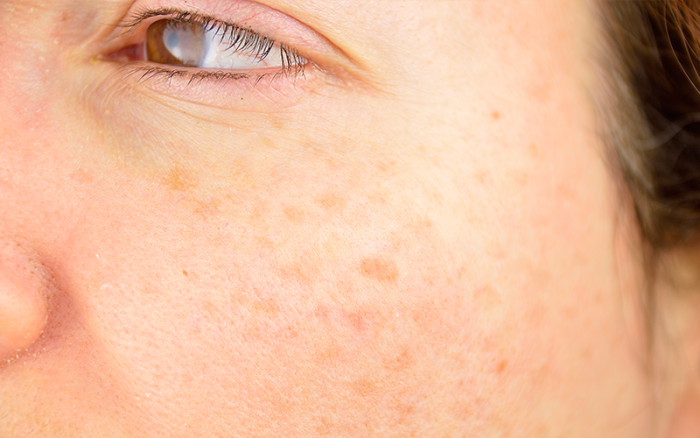As we get older, our skin faces new challenges like wrinkles, frown lines and sunspots.
Sunspots, also known as age spots or liver spots, are caused by a lifetime of sun exposure. These flat, brown spots appear on the parts of your body that get the most sun, including your arms, legs, the backs of the hands, shoulders, chest, and face. And once you have them, they get bigger, darker and more numerous with more sun exposure.
Almost everyone eventually gets sunspots, but those with fair skin are especially vulnerable. Sunspots themselves are harmless, but some skin cancers look like sunspots and shouldn’t be ignored.
When should you be worried about sunspots on your face and body?
Sunspots or Skin Cancer?
Sunspots, also called solar lentigo, occur when ultraviolet light (UV) exposure speeds up the production of melanin, causing the pigment in your skin to darken.
These dark spots on the skin are not painful, itchy or harmful, but if you have a lot of sunspots, it’s an indication that you’ve had a lot of sun exposure throughout your lifetime. This doesn’t mean that you have skin cancer, necessarily, but it does mean that you are at an increased risk of developing skin cancer on the areas of skin that have a lot of sunspots.
The danger is that the most common skin cancers such as basal cell carcinoma, squamous cell carcinoma, or even melanoma can look like a sunspot in the earliest stages. Many types of skin cancer also begin as a flat, brown patch. Like sunspots, these cancers often have irregular borders and can vary in shade and color.
“At first glance, skin cancer may look a lot like a harmless sunspot,” says Dr. Russell Peckham, a dermatologist with U.S. Dermatology Partners Cedar Park. “Have a dermatologist check your skin at least once a year and always see your doctor if the size, shape or color of a spot changes or if it itches or bleeds.”
A dermatologist can identify a cancerous spot on your skin by performing a simple biopsy. Your doctor can also help you tell the difference between a sunspot and skin cancer so that you can perform your own skin exams more frequently at home.
The Effect of Sun Damage on Aging Skin
Sun damage is cumulative — it occurs over your lifetime after repeated and extended sun exposure — and accelerates the normal aging process. As you get older, the effects of sun exposure take a toll on your skin. Depending on your age, the damage you incur now may not show up until later in life.
In addition to sunspots, the sun’s ultraviolet (UV) light damages fibers in the skin called elastin. As elastin breaks down over time, and skin begins to sag and stretch as you age, your skin loses its ability to “snap” back into place.
Sunspots and sun damage can affect anyone but are more common in those with light skin or a previous occurrence of skin cancer. Individuals with moles, freckles, light eyes and hair or with a family history of sun damage or skin cancer are also at a greater risk.
Treatment for Sunspots and Sun Damage
Long-term sun damage is difficult to treat because the damage caused to the collagen in the skin is permanent and can’t be reversed. Most sunspots fade somewhat over time, but they will typically not disappear completely because the skin has been permanently damaged.
There are, however, several treatments to diminish the appearance of sunspots. Bleaching creams and acid peels can make the appearance of sunspots less obvious. Other treatments include chemical peels, cryotherapy, and laser skin resurfacing, which allows new skin to grow in place of the old, damaged skin.
The truth is, the sun exposure you have before the age of 20 is a major determining factor of how your skin will look when you are older. But don’t panic — it’s never too late to start taking care of your skin! Every day that you protect your skin from damaging UV rays will help your skin look more youthful down the road.
“The best way to deal with sunspots is to prevent them by limiting your sun exposure,” says Dr. Peckham. “When you’re out in the sun, always wear a broad-spectrum sunscreen with an SPF of 30 or higher and stay out of the sun during the middle of the day, when ultraviolet rays are strongest.”
Other ways to protect your skin from sun damage include wearing protective clothing such as long sleeves, pants, a wide-brimmed hat, and UV-filtering sunglasses.
Generally speaking, sunspots on your face are nothing to worry about. But if you have any unusual (or new) marks on your skin, it is important to have them checked out by a dermatologist as soon as possible to make sure it’s not something more serious.
Looking to Visit a Dermatologist?
Do you have sunspots or have you noticed changes in your skin? If you have a sunspot or mole that has changed in size or color — or a new mole or growth — contact U.S. Dermatology Partners today to speak with one of our board-certified dermatologists. We have multiple locations throughout the country, so fill out our simple online form to get in touch with us. One of our local team members will reach out to you shortly to answer your questions or schedule an appointment for you to visit us soon.
Find a location near me
or

